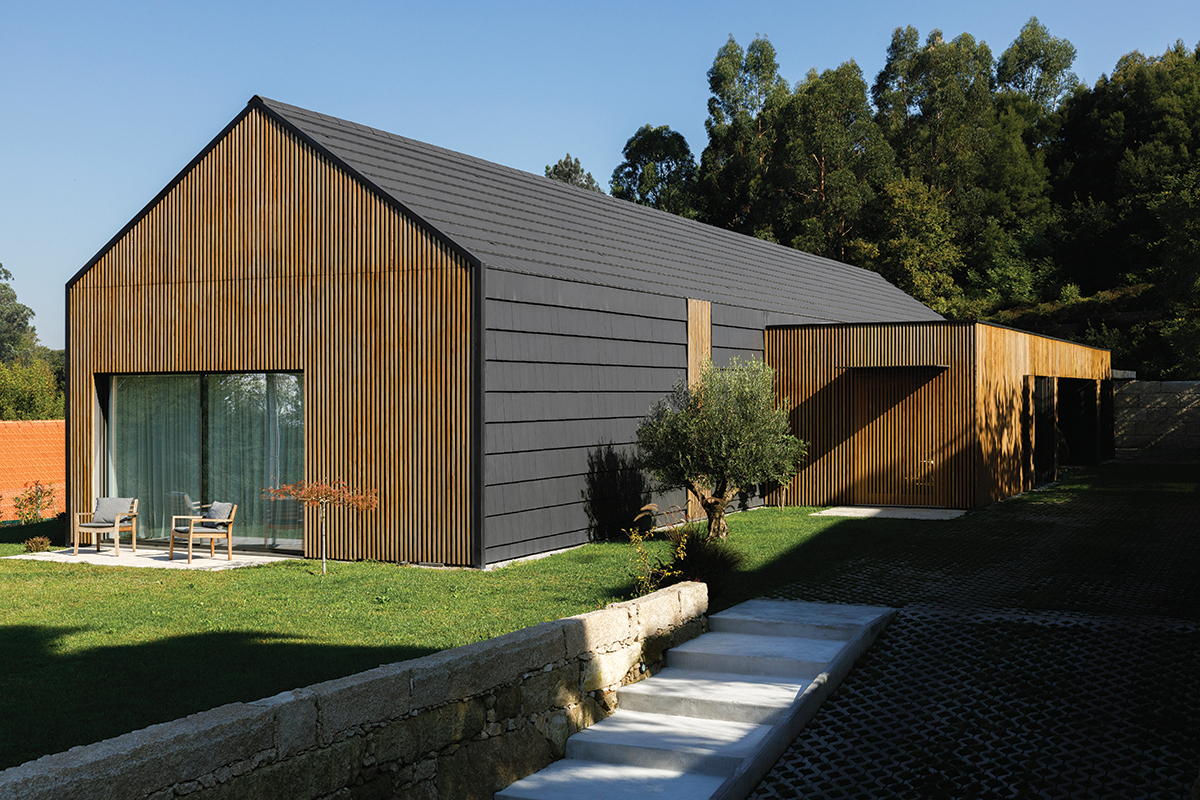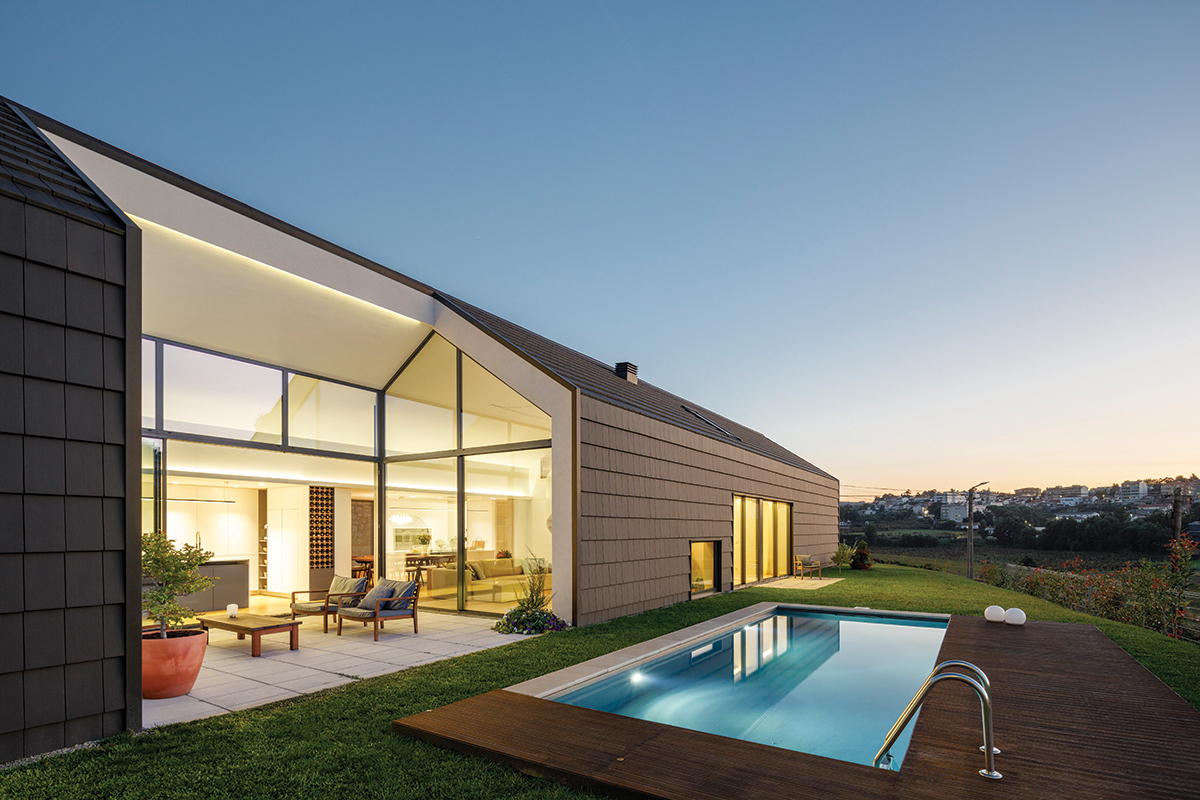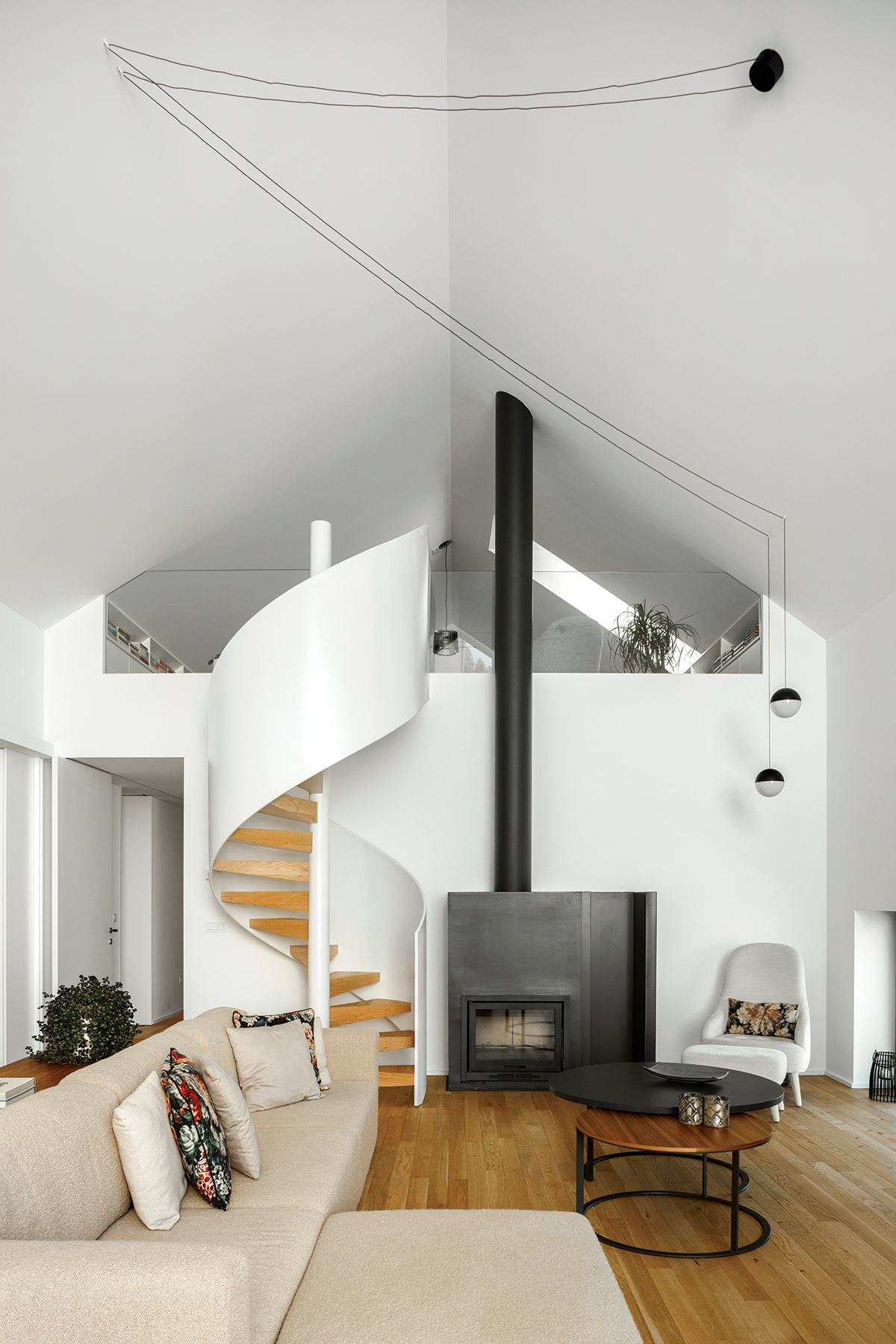


작은 언덕 위에 자리한 주택 Santo Tirso House는 수풀과 나무를 등지고 어두운 실루엣으로 대조를 이루며 아름다운 도시 Santo Tirso를 내려다보고 있다. 주택의 외형을 이루고 있는 단순한 라인은 포르투갈 전통 주택에서 흔히 볼 수 있는 박공지붕을 재해석한 것이다. Hous3는 부지 위 남동쪽에서 북동쪽, 세로로 이어지는 축을 중심으로 사이트에서 얻을 수 있는 최적의 뷰를 찾아 주택의 평면을 설정했다. 이로 인해 주택의 주요 볼륨은 전통적인 주택을 재치있게 재해석한 동(棟)으로 디자인됐고, 주요 볼륨에 달린 듯한 작은 볼륨은 전통 주택에서 흔히 볼 수 있으며 생활에 있어서 부차적인 역할을 수행하는 공간으로서 제안됐다.


From the road you can see the house, on a small hill, with a dark silhouette in sharp contrast to its natural environment, offering a wide view over Santo Tirso. Its simple lines are the reinterpretation of the stereotype of the traditional Portuguese house, gable roof. We started by defining a northeast-southeast axis in the longitudinal direction of the land and oriented in the best view of the place. And in this linear orientation, the main volume is arranged, in a playful reconfiguration of the traditional house, it becomes remarkable in the landscape.
A smaller, fat volume is attached to this one, which in addition to completing the programmatic requirements of housing is also an allusion to the annexes that traditionally are constant additions to the main house. This volume departs from the entrance of the lot to create a kind of external decompression atrium. And in the simplicity of the composition of these two volumes, an intuitive understanding of spaces is promoted, inviting us to enter.

In terms of the program's distribution, the reception lobby is the first point of contact with the house, leading us to the central and common areas of the house: dining room, living room and kitchen, spacious and generous with lots of natural light promoted by negative space, which is used as the extension of the indoor room to the outside, to the pool and outdoor dining room, taking advantage of the rhythmic play of light in the afternoon. This central block also allows us to separate two spaces that were to be independent.


주택의 내부로 들어서면 박공지붕의 형태를 따라 경사지고 뾰족한 천장의 실내 공간을 만나게 된다. 두 볼륨의 허리를 뚝 잘라 테라스 공간을 만들었으며, 큰 볼륨에는 거실, 주방과 다이닝 등 생활공간을 두었고, 테라스와 연결성을 해치지 않도록 천장까지 닿는 통유리 슬라이딩 도어로 실내와 외부를 구분했다. 이로 인해 실내의 확장감이 극대화됐고, 테라스와 그 너머의 우거진 수풀까지를 실내에서 조망할 수 있다. 통유리 슬라이딩 도어는 필요에 따라 전면 개방이 가능하기 때문에 볕이 좋은 날에는 활짝 열어두고 공간을 활용할 수 있도록 했다.


To the northeast, the technical areas of housing and work, with double height; Over these two areas, the traditional shape of the gable roof allowed the interior spaces to be modeled to complement the nature of the programs, creating a place for reading and studying. Due to the simplicity and relevance of its interior design, with light, minimalist and smooth walls, it offers a peaceful living space. In contrast to the dark exterior, where the black plant tile and the pine together with the simple shape of the building create a striking graphic silhouette against the landscape. On the whole, through the juxtaposition of its facade materials, we get closer to the natural, the beautiful, where we hope that its inhabitants are happy.


거실에는 나선형의 계단을 두어 박공지붕의 형태로 인해 형성된 다락 공간으로 다다를 수 있도록 했다. 가벼운 느낌의 나선형 계단 디자인과 더불어 다락의 유리 난간은 독특한 레이아웃과 확장감이 넘치는 실내 공간에서 시야가 가로막히지 않도록 하기 위한 아이디어였다. 다락 역시 포르투갈 전통 박공지붕의 주택에서 흔히 볼 수 있는 공간으로, 기능성은 끌어올리고 현대적인 디자인을 가미해 모던하게 완성했다. 클라이언트는 아래층의 거실과 단절된 듯 연결된 이곳 다락에서 조용히 차를 마시거나 책을 읽는다.
Santo Tirso House는 단순한 하나의 매스 위에서 서로 다른 소재와 컬러를 통해 실내외가 정반대의 인상을 주는 독특한 주택이다. 특히 내부 공간의 일면을 보여주며 뚝 잘라낸 듯 구성한 테라스 공간은 볼드하고 묵직한 외관과 가볍고 부드러운 내부가 명확히 대조되며 주택이 가진 매력을 더욱 극적으로 드러내는 장치가 되기도 한다.
작은 언덕 위 최적의 뷰를 자랑하는 주택, Santo Tirso House
- 차주헌 기자
- 2021-02-04 14:41:06
- 조회수 2172
- 댓글 0
차주헌
저작권자 ⓒ Deco Journal 무단전재 및 재배포 금지











0개의 댓글
댓글 정렬